Kia Sportage: Intake Air Temperature Sensor (IATS) | Engine Coolant Temperature Sensor (ECTS)
Description and Operation
Description
Intake Air Temperature Sensor (IATS) is included inside Manifold Absolute Pressure Sensor and detects the intake air temperature.
To calculate precise air quantity, collection of the air temperature is needed because air density varies according to the temperature. So the ECM uses not only MAPS signal but also IATS signal. This sensor has a Negative Temperature Coefficient (NTC) Thermister and it's resistance changes ii reverse proportion to the temperature.
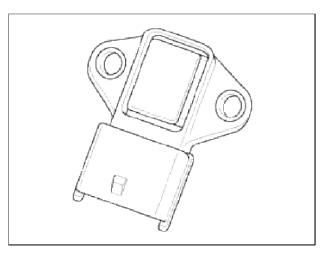
Specifications
Specification
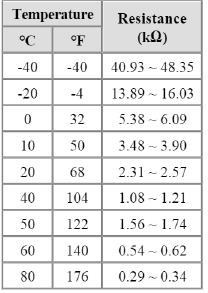
Schematic Diagrams
Circuit Diagram
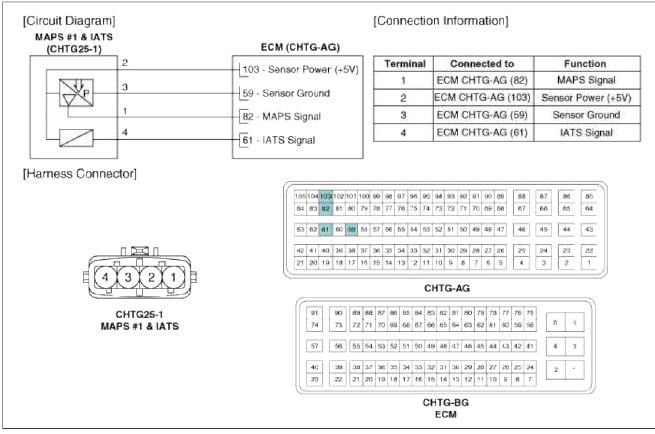
Repair procedures
Inspection
1. Turn the ignition switch OFF.
2. Disconnect the IATS connector.
3. Measure resistance between the IATS terminals 3 and 4.
4. Check that the resistance is within the specification
Specification: Refer to "Specification"
Engine Coolant Temperature Sensor (ECTS)
Description and Operation
Description
Engine Coolant Temperature Sensor (ECTS) is located in the engine coolant passage of the cylinder head for detecting the engine coolant temperature. The ECTS uses a thermistor that changes resistance with the temperature.
The electrical resistance of the ECTS decreases as the temperature increases, and increases as the temperature decreases. The reference +5V is supplied to the ECTS via a resistor in the ECM. That is. the resistor in the ECM and the thermistor in the ECTS are connected in series. When the resistance value of the thermistor in the ECTS changes according to the engine coolant temperature, the output voltage also changes.
During cold engine operation the ECM increases the fuel injection duration and controls the ignition timing using the information of engine coolant temperature to avoid engine stalling and improve drivability.
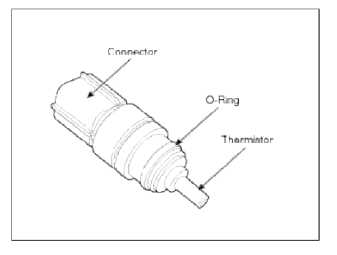
Specifications
Specification
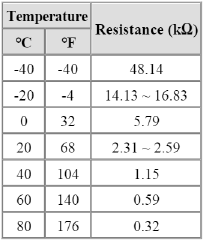
Schematic Diagrams
Circuit Diagram
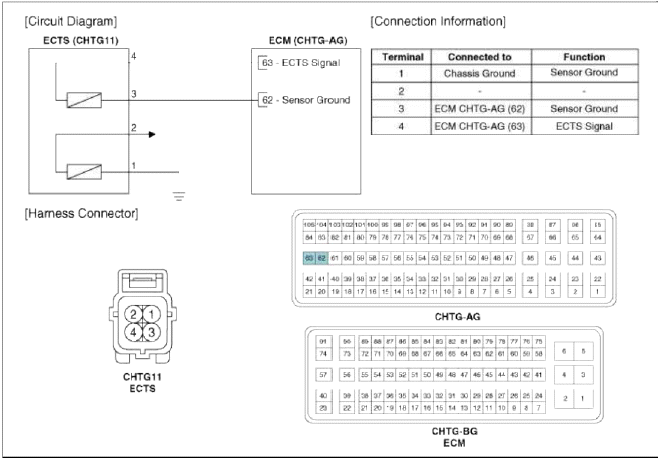
Repair procedures
Inspection
1. Turn the ignition switch OFF.
2. Remove the ECTS (Refer to "Removal").
3. After immersing the thermistor of the sensor into engine coolant, measure resistance between the ECTS terminals 3 and 4.
4. Check that the resistance is within the specification.
Specification: Refer to "Specification"
Removal
1. Turn the ignition switch OFF and disconnect the battery negative (-) cable.
2. Disconnect the engine coolant temperature sensor connector (A).
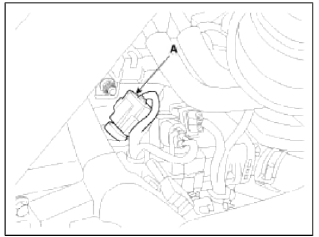
3. Remove the spring clip (A), and then pull the sensor from the water temperature control assembly.
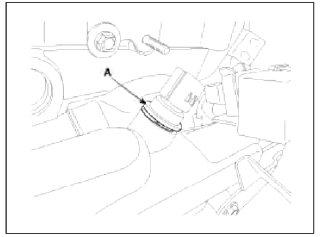
CAUTION
Note that engine coolant may be flowed out from the water temperature control assembly when removing the sensor.
4. Supplement the engine coolant (Refer to "Cooling System" in EM group).
Installation
CAUTION
- Install the component with the specified torques.
- Note that internal damage may occur when the component is dropped. If the component has been dropped, inspect before installing.
CAUTION
- Apply the engine coolant to the O-ring.
CAUTION
- Insert the sensor in the installation hole and be careful not to damage.
1. Installation is reverse of removal.
READ NEXT:
 Crankshaft Position Sensor (CKPS)
Crankshaft Position Sensor (CKPS)
Description and
Operation
Description
Crankshaft Position Sensor (CKPS) detects the crankshaft position and is one
of the most important sensors of the
engine control system. If there is n
 Knock Sensor (KS) | Heated Oxygen Sensor (HO2S)
Knock Sensor (KS) | Heated Oxygen Sensor (HO2S)
Description and Operation
Description
Knocking is a phenomenon characterized by undesirable vibration and noise and can cause engine damage. Knock Sensor (KS) is installed on the cylinder blo
SEE MORE:
 Welding procedures
Welding procedures
Observe the following tips when welding.
1. Wear appropriate eye protection.
2. Carefully follow the manufacturers operating
instructions for the welding machine you are using.
3. Do not weld, smoke or allow open flames around
volatile chemicals, cleaners or solvents or in any
area where t
 Controlling fan speed
Controlling fan speed
The fan speed can be set to the desired
speed by operating the fan speed control
button.
To change the fan speed:
Press button right for higher speed, or
press button left for lower speed.
Type A (button)
Type B (control panel)
To turn the fan speed control off:
Press the
Content
- Home
- Kia Sportage - Fifth generation (NQ5) - (2022-2025) - Owner's Manual
- Kia Sportage - Second generation (JEKM) (2005-2015) - Body Workshop Manual
- Kia Sportage Third generation (SL) - (2011-2016) - Service and Repair Manual
- Sitemap
- Top articles